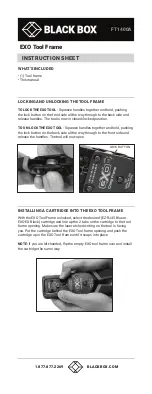
7 ENGLISH
N m
.
70
60
50
40
30
20
10
M10(3/8")
M8(5/16")
M6(1/4")
(ft lbs)
(50)
(44)
(37)
(30)
.
(22)
(15)
(7)
(3/8")
(5/16")
(1/4")
Fastening time
Seconds
Fastening torque
High tensile bolt BTW073
0
0
1
2
3
(M10)
(M8)
(M6)
(M6)
Standard bolt BTW103
(M10)
M6(1/4")
60
40
20
M10
M8(5/16")
(M8)
N m
.
(ft lbs)
.
(43)
(29)
(14)
(3/8")
(5/16")
(3/8")
(1/4")
0.5
0
Fastening time
Seconds
Fastening torque
1.5
1.0
0
70
M12(1/2")
(M12)
(49)
(1/2")
120
100
80
60
40
20
0
1
2
Fastening time
Seconds
Fastening torque
High tensile bolt BTW103
M10
(M10) (3/8")
M8 (5/16")
(M8)
0
N m
.
(ft lbs)
.
(87)
(72)
(58)
(43)
(29)
(14)
(3/8")
(5/16")
NOTE:
•
When fastening bolt M8 or smaller, carefully
adjust pressure on the switch trigger so that the
screw is not damaged.
•
Hold the tool pointed straight at the bolt or nut
without applying excessive pressure on the tool.
•
Excessive fastening torque may damage the
bolt/nut or socket. Before starting your job,
always perform a test operation to determine
the proper fastening time for your bolt or nut.
Especially for the bolt smaller than M8, perform
the above test operation to prevent the trouble
on socket or bolt, etc.
•
If the tool is operated continuously until the
battery cartridge has discharged, allow the tool
to rest for 15 minutes before proceeding with a
fresh battery cartridge.
The fastening torque is affected by a wide variety of
factors including the following. After fastening, always
check the torque with a torque wrench.
1.
When the battery cartridge is discharged almost
completely, voltage will drop and the fastening
torque will be reduced.
2. Socket
•
Failure to use the correct size socket will
cause a reduction in the fastening torque.
•
A worn socket (wear on the hex end or
square end) will cause a reduction in the
fastening torque.
3. Bolt
•
Even though the torque coefficient and the
class of bolt are the same, the proper fasten-
ing torque will differ according to the diame-
ter of bolt.
•
Even though the diameters of bolts are the
same, the proper fastening torque will differ
according to the torque coefficient, the class
of bolt and the bolt length.
4. The use of the universal joint or the extension
bar somewhat reduces the fastening force of the
impact wrench. Compensate by fastening for a
longer period of time.
5.
The manner of holding the tool or the material
of driving position to be fastened will affect the
torque.
6.
Operating the tool at low speed will cause a reduc-
tion in the fastening torque.
MAINTENANCE
CAUTION:
•
Always be sure that the tool is switched off and
the battery cartridge is removed before attempt-
ing to perform inspection or maintenance.
•
Never use gasoline, benzine, thinner, alcohol
or the like. Discoloration, deformation or cracks
may result.








































